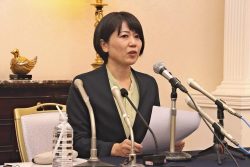
The leaders of ruling and opposition parties make speeches on Wednesday.
12:15 JST, June 22, 2022
Official campaigning for the 26th House of Councillors election began Wednesday, with hundreds of candidates to face off for 18 days ahead of the voting and ballot-counting scheduled for July 10.
The upcoming election will be a referendum on the performance of Prime Minister Fumio Kishida’s administration, which was launched in October last year. The ruling and opposition parties are sparring over such issues as surging prices, the post-pandemic economic recovery, and security policy issues including defense spending.
The number of upper house seats has increased by three to 248. Members of the upper house are elected for six-year terms, with half the seats, or 124, up for election every three years. This time, 125 seats will be contested, with 74 chosen from constituencies, 50 through proportional representation and one seat in the Kanagawa constituency that was vacated last year.
Applications for candidacy began being accepted from 8:30 a.m. on Wednesday — at the election administration commission of each prefecture for constituencies, and at the Central Election Management Council within the Internal Affairs and Communications Ministry for proportional representation.
A total of 545 candidates had submitted applications, including 367 in the constituencies and 178 in the proportional representation segment. In the last upper house election in 2019, there were a total of 370 candidates — 215 in the constituencies and 155 in the proportional representation race.
Seeking to repeat the Liberal Democratic Party’s success in the October 2021 House of Representatives election, Kishida has defined victory as securing the upper house majority of at least 125 seats — including the number of uncontested seats — in combination with its coalition partner Komeito.
Kishida is also president of the Liberal Democratic Party.
The ruling coalition has 69 uncontested seats, meaning they will need 56 seats in the upcoming election to meet this goal. They would be able to secure a majority among the contested seats by winning at least 63 seats in the upcoming election.
The results of 32 constituencies nationwide with one seat available will play a key role in determining the race.
In the 2016 and 2019 upper house elections, the opposition camp made arrangements to field a single candidate in all constituencies in which one seat was contested, snaring 11 wins in 2016 and 10 wins in 2019. This time, however, the opposition parties fielded many candidates of their own, and the number of arranged single candidates will be limited to 11 constituencies.
Another focus in the upcoming election is whether parties positive toward constitutional revision can secure the two-thirds majority, or 166 seats, required to initiate a constitutional amendment in the Diet.
Among the upper house members whose seats are not in contention this time, 84 seats are held by lawmakers in favor of constitutional revision who belong to one of four pro-revision parties — the ruling parties, Nippon Ishin no Kai (Japan Innovation Party), and the Democratic Party for the People (DPFP) — as well as Seiko Hashimoto who is not affiliated with any party.
To maintain the minimum two-thirds majority, 82 seats will be need to be secured in the upcoming election. In the lower house, the number of seats held by pro-amendment people exceeds two-thirds of the total 465 seats.
On Wednesday morning, leaders of each party held their first speeches after the campaign’s kickoff.
“To which party should you entrust major issues such as the coronavirus pandemic, the situation in Ukraine and rising prices?” Kishida said in Fukushima. “Political stability is necessary, and only the LDP and Komeito can overcome those challenges.”
Komeito Chief Representative Natsuo Yamaguchi said in Yokohama: “We will take on the challenge of rebuilding the economy, building a social security system that protects all generations and strengthening national security.”
Speaking in Aomori, Constitutional Democratic Party of Japan President Kenta Izumi said: “Prices are rising, and life is tough. [Politics] will change if opposition parties raise their voices.”
In Osaka, Ishin leader Ichiro Matsui said: “We ask you to lift Ishin to the leading opposition party position. We must put pressure on the LDP to sharpen it up.”
Japanese Communist Party chief Kazuo Shii said in Tokyo, “The path Japan should take is peaceful diplomacy based on Article 9 of the Constitution.” DPFP leader Yuichiro Tamaki said in Inuyama, Aichi Prefecture: “Raising salaries and protecting the country — we will fight based on those two pillars.”
Reiwa Shinsengumi leader Taro Yamamoto, Social Democratic Party chief Mizuho Fukushima and Takashi Tachibana, head of the party to protect the people from NHK, also made street speeches in Tokyo.
"Politics" POPULAR ARTICLE
-

Japan to Support Central Asian Logistics Route That Bypasses Russia, Plan to Be Part of Upcoming Summit in Tokyo
-

Japan to Tighten Screening of Foreigners’ Residential Status by Providing Information of Nonpayment of Taxes
-

Chinese, Russian Bombers Flew Unusual Path by Heading Toward Tokyo; Move Likely Meant to Intimidate Japan
-

Japan Plans National Database to Track Foreign Ownership of Real Estate, Land as It Weighs New Rules
-

Up to 199,000 Deaths Estimated From Mega-Tsunami; Most Recent Occurrence Took Place in 17th Century
JN ACCESS RANKING
-

Tokyo Economic Security Forum to Hold Inaugural Meeting Amid Tense Global Environment
-

Keidanren Chairman Yoshinobu Tsutsui Visits Kashiwazaki-Kariwa Nuclear Power Plant; Inspects New Emergency Safety System
-

Imports of Rare Earths from China Facing Delays, May Be Caused by Deterioration of Japan-China Relations
-

University of Tokyo Professor Discusses Japanese Economic Security in Interview Ahead of Forum
-

Japan Pulls out of Vietnam Nuclear Project, Complicating Hanoi’s Power Plans



























